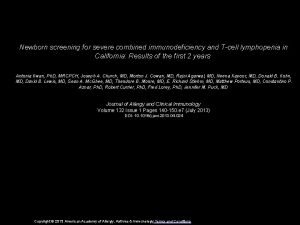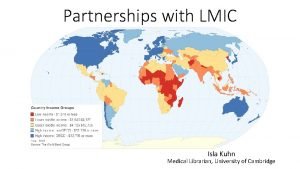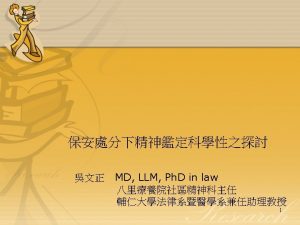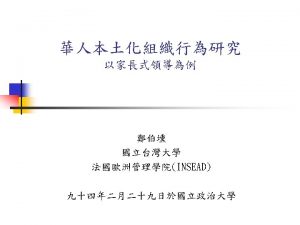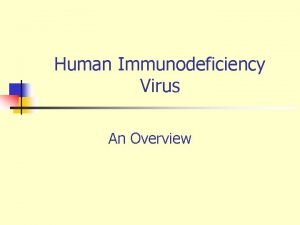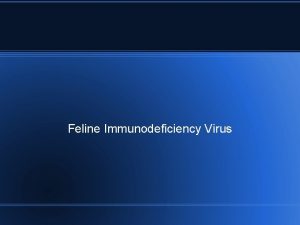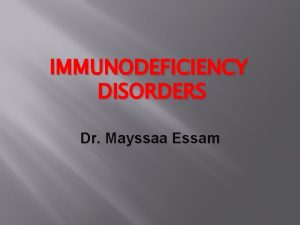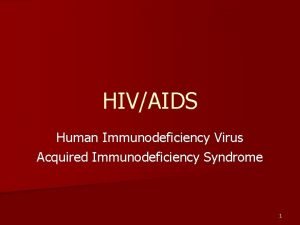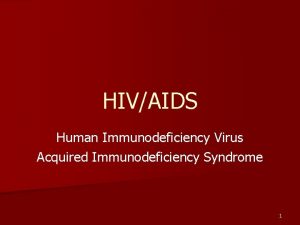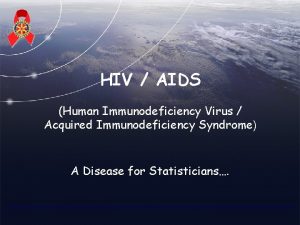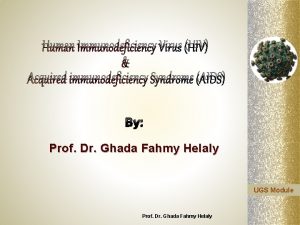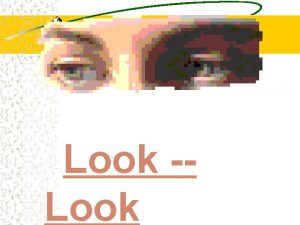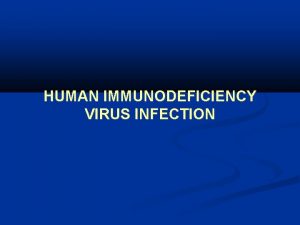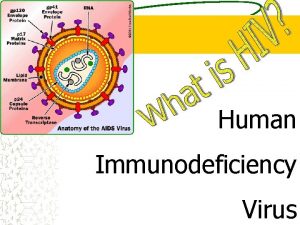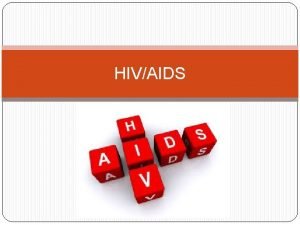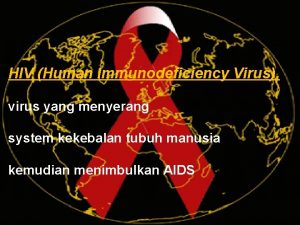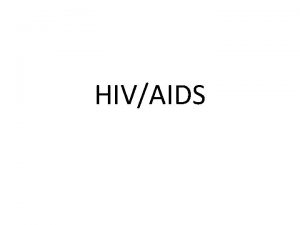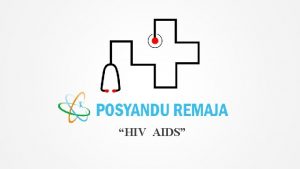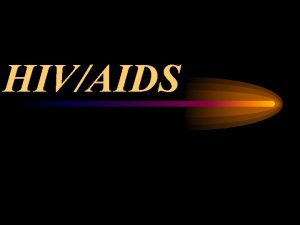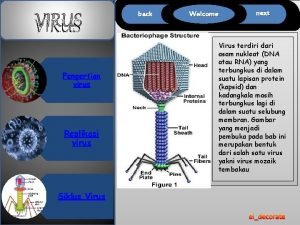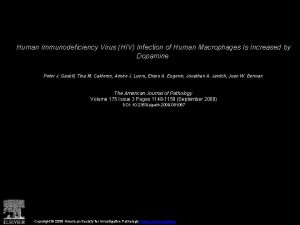Human Immunodeficiency Virus Kyle Kuhn Gerard Jenkins and





























- Slides: 29

Human Immunodeficiency Virus Kyle Kuhn, Gerard Jenkins and Agnes Kazior March 11, 2003

What is HIV? • Any of several retroviruses that infect and destroy helper T cells of the immune system

• HIV is a lentivirus – genus of the retroviridae family – produce multi-organ diseases – characterized by long incubation periods and persistent infection – infect a wide range of prime hosts, as well as some non-primate mammals Courgnaud et al. J. Virol. 75: 857, 2001

Two Types of HIV

HIV-1 vs. HIV-2 • HIV-1 – More virulent – Responsible for worldwide epidemic – Severity of infection varies from person to person • HIV-2 – Primarily found in western Africa – Not transmitted as efficiently – Genome more closely related to SIVmm than HIV-1

Origins of HIV-1 likely descended HIV-2 likely descended from SIVcpz from SIVsm Pan troglodytes Sooty Mangabey

Origins of HIV • Researchers claim that these chimps are the source of HIV-1 – Chimps are only rarely infected with SIVcpz – Actual Reservoir maybe a third unidentified primate species • Definite source remains elusive

Zoonosis: How did it happen? • Human killing and eating of chimpanzees • contact with infected blood • ingestion of uncooked or undercooked meat • Chat - polio vaccine • Hypothesis: HIV is a recombinant construct that occurred when SIV from a contaminated vaccine was administered to humans and arose when human antigens were incorporated into the SIV – Two reports in 2001 discount this theory (Blanco P. et al. and Berry N. et al. )

Zoonosis: When did it happen? • Three earliest know HIV infections • 1959 - serum sample from an adult male living in what is now the Democratic Republic of Congo • 1969 - tissue samples from a teenager who died in St. Louis • 1976 - tissue samples from a Norwegian sailor • January 2000 - study by Dr. Bette Korber estimates first case of HIV infection to be 1930 • Study based on complicated computer model of HIV’s evolution and has a 20 yr error margin

Zoonosis: Where did it happen? • The two primates that carry the SIVs most closely related to HIV are indigenous to western Africa

HIV A Brief History of the modern epidemic

In The Beginning. . . • 1675 - Speculation that HIV was first transmitted from chimpanzees to humans • 1926 -1946 - Scientists believe HIV first spread from monkeys to humans • 1959 - First proven AIDS death • 1978 - Gay men in US and Sweden begin showing signs of what is now known as AIDS

The First Indications • 1981 - CDC notices increase in cases of Kaposi’s sarcoma and Pneumocystis carinii pneumonia

Defining The Problem • 1982 - The term AIDS (acquired immune deficiency syndrome) is used for the 1 st time • 1983 - Institut Pasteur isolates HIV-1 CDC issues warning to blood banks about potential problem • 1984 - Dr. Robert Gallo claims discovery of HIV

The Start of the War • 1985 - FDA approves first HIV antibody diagnostic test - First International Conference on AIDS • 1986 - HIV-2 isolated • 1987 - AZT approved by FDA (1 st anti. HIV drug)

Reality Sets In • 1987 - President Reagan says “AIDS” in public - AIDS memorial quilt started

The War Against HIV/AIDS • 1988 - FDA begins granting preapproval distribution status to HIV/AIDS related drugs • 1989 - First licensed HIV-1 diagnostic kit to directly detect virus (rather than antibodies)

Fighting a Losing Battle? • 1991 - 10 million people worldwide are HIV-positive - Magic Johnson publicly announces he is HIV positive

Increasing The Arsenal • 1992 - FDA starts “accelerated approval” process for HIV/AIDS related drugs • 1995 - Saquinavir (Invirase) is first protease inhibitor approved in US - US admits that Institut Pasteur, not Dr. Gallo, discovered HIV • 1996 - Nevirapine (Viramune) first nonnucleoside reverse transcriptase inhibitor approved in US

Current Status • 1997 - 6, 400, 000 Approximate worldwide death total - 22, 000 HIV-positive people in the world • 1998 -2001 - development and approval of new drugs • 2003 - AIDSVAX developed by Vax. Gen fails in large clinical trial » Trial did show statistically significant prevention in African-Americans and other non-Hispanic minorities

AIDS in the US


Transmission & Prevention • Unprotected sex • Vagina, Penis, Anal, Oral • Shared needles • Drugs, Steroids, Tattoo, Piercing • Mother to child • Birth, Breast Feeding • Blood transfusions • Abstinence • Protection during sex • Condom, Latex barrier • Avoiding risky behavior • Not sharing needles, no promiscuous activity

HIV vs. AIDS • HIV causes AIDS by attacking the immune system’s CD 4 T cells. • Normal CD 4 count is between 500 – 1500 CD 4 T cells per ul of blood, while AIDS CD 4 count is less than 200 CD 4 T cells per ul of blood. • AIDS viral load is about 55, 000 HIV RNA copies per ml of blood. • On average, it takes approximately 10 years to develop AIDS from initial infection. • As a person’s CD 4 count decreases, he/she is more prone to opportunistic infections.

HIV in U. S. • As of January 2001, there were about 850, 000 people living with HIV in the U. S. • Approximately 40, 000 new HIV infections occur in the U. S. every year.

AIDS in U. S. Age Cases % 1 – 19 13, 502 1. 7 20 – 34 312, 889 38. 3 35 – 49 399, 244 48. 9 50 – 65+ 90, 513 11. 1 Race White Black Hispanic AIDS Cases 343, 889 313, 180 149, 752 Asian Native 6, 157 2, 537 • As of January 2002, there were 816, 149 reported cases of AIDS in the United States. • As of January 2002, there were 467, 910 reported deaths due to AIDS in the United States.

HIV/AIDS in Africa

HIV/AIDS in Africa • During 2001, there were 3. 4 million new HIV infections, 2. 3 million AIDS deaths in Africa. • As of January 2002, approximately 28 million people are living with AIDS in Africa. • The life expectancy is 47 years with AIDS and 62 years without AIDS.

HIV/AIDS World Wide • • Approximately 42 million people are living with HIV or AIDS. About 5 million people were infected with HIV during 2002. About 3. 1 million people died of AIDS during 2002. Approximately 21. 8 million people have died of AIDS since the epidemic began.
 Thomas khum
Thomas khum What are deficiency
What are deficiency Severe combined immunodeficiency
Severe combined immunodeficiency Stufen der partizipation nach kühn
Stufen der partizipation nach kühn Ciencia segun thomas kuhn
Ciencia segun thomas kuhn Positivism sociology
Positivism sociology Interpretativizmus
Interpretativizmus Thomas samuel kuhn
Thomas samuel kuhn Popper vs kuhn
Popper vs kuhn Popper vs kuhn
Popper vs kuhn Amrican poker
Amrican poker Chandlee kuhn
Chandlee kuhn Peter kuhn model
Peter kuhn model Victor spinski
Victor spinski Thomas kuhn a tudományos forradalmak szerkezete pdf
Thomas kuhn a tudományos forradalmak szerkezete pdf Sinângio
Sinângio Kondisi kuhn tucker
Kondisi kuhn tucker Eulti
Eulti Kuhn tucker
Kuhn tucker Latifa kühn
Latifa kühn Kuhn perry
Kuhn perry Interne zinsfußmethode formel
Interne zinsfußmethode formel Jeff kuhn artist
Jeff kuhn artist Racionális érv rejtvény
Racionális érv rejtvény Paradigm shift kuhn
Paradigm shift kuhn Haley kuhn
Haley kuhn Kuhn social science
Kuhn social science Cupid greek mythology
Cupid greek mythology Cupid and psyche francois gerard
Cupid and psyche francois gerard My sister amy my friend kyle and i went to the park
My sister amy my friend kyle and i went to the park


